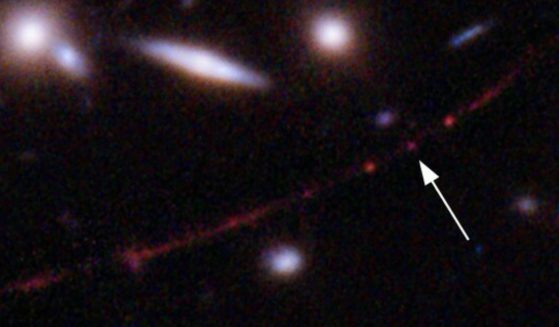
“I will give thanks to You, for I am fearfully and wonderfully made; Wonderful are Your works, And my soul knows it very well.” — Psalm 139:14
Astronomers recently announced the discovery of the oldest star ever seen — one long dead but hailing from the earliest days of the universe.
On March 30, astronomer Brian Welch, a doctoral student at Johns Hopkins University, announced the discovery of the blue star, nicknamed Earendel.
In images of a cluster of stars, Welch said he and colleagues noticed a red arc that was long and thin. They soon realized “the arc was a background galaxy whose light the cluster had warped and amplified,” according to Science News.
Welch added that a bright dot atop the red arc was too small to be another galaxy or cluster of stars.
“We stumbled into finding that this was a lensed star,” he said.
Earendel has been estimated as having existed nearly 13 billion years ago and flared into existence at the dawn of the cosmos.
“We’re seeing the star as it was about 12.8 billion years ago, which puts it about 900 million years after the Big Bang,” Welch said in his paper, which appeared in the journal Nature at the end of March.
The light from Earendel, seen for the first time through the Hubble Space Telescope, took eons to reach us even as the star has long since gone supernova and died.
In most cases, the oldest stars are impossible to pick out because there is too much interference from other stars to identify them.
“Usually they’re all smooshed together … But here, nature has given us this one star — highly, highly magnified, magnified by factors of thousands — so that we can study it,” said NASA astrophysicist Jane Rigby, according to Phys.org. “It’s such a gift really from the universe.”
“We definitely just got lucky,” Welch said of discovering Earendel.
Astronomer Katherine Whitaker, of the University of Massachusetts Amherst, praised the find, saying, “These are the sorts of things that you only hope you could discover,” according to Science News.
Welch and his team chose the name Earendel as a “fitting name for a star that we have observed in a time often referred to as ‘Cosmic Dawn.’”
Earendel is an Old English word meaning “morning star” or “rising light.”
Earendel takes its place as the oldest star ever seen, ahead of the previous record holder, Icarus, which astronomers estimate as 9.4 billion years old.
“In both instances,” Phys.org explained, “astronomers used a technique known as gravitational lensing to magnify the minuscule starlight. Gravity from clusters of galaxies closer to us — in the foreground — serve as a lens to magnify smaller objects in the background. If not for that, Icarus and Earendel would not have been discernible given their vast distances.”
Scientists say Earendel was more than 50 times the size of our sun and 1 million times brighter. Its galaxy also was a chaotic pattern of stars lumped together.
It is not known how much of Earendel’s galaxy still exists after it exploded and burned out, but parts of it likely merged with other galaxies.
Now that it has been identified, astronomers hope to take a better look at Earendel with the more powerful Webb Space Telescope.
Indeed, Earendel’s discovery with the weaker Hubble Telescope has astronomers excited for what they will be able to see with the Webb. That telescope came online this past winter.
Scientists continue to make interesting discoveries across the universe. In January, astronomers were baffled to see a rhythmic flashing in the night sky, which they determined was radiation from an unknown object.
And last year, a discovery was made closer to home when scientists announced a never-before-seen moonlet, named Kamo’oalewa, orbiting the Sun in a manner that brings it close to Earth’s orbital path.
These continuing discoveries show just how little we truly know about the cosmos. And it can’t help but evoke wonder and amazement at the majesty of creation.
There still are many amazing, undreamed discoveries of God’s handiwork yet to come, things we are just starting to understand as we reach out to see what is beyond our little blue marble.
